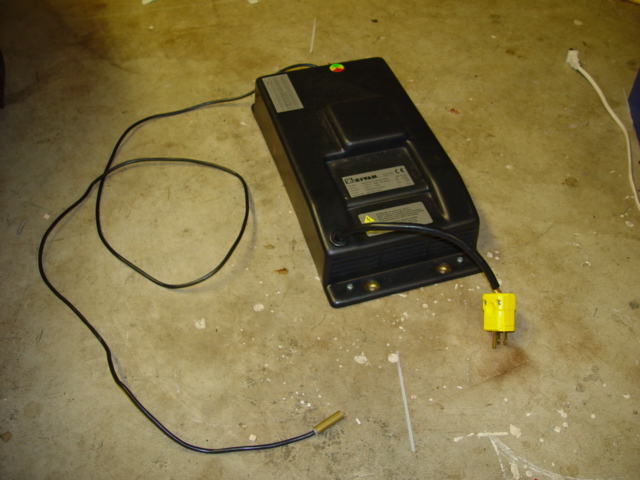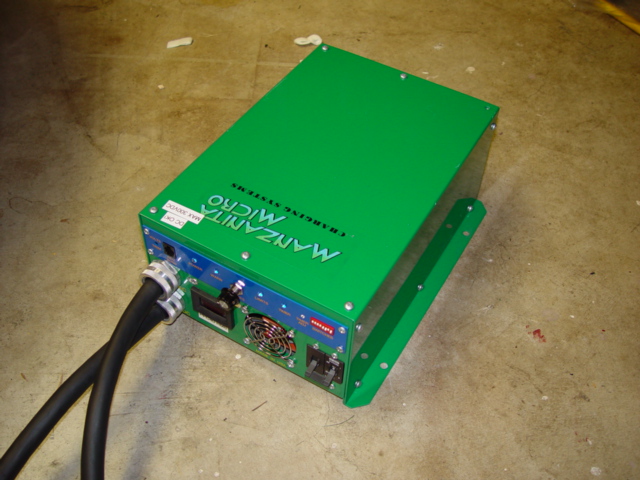
|
Sparrow / NmG
Wiki |
Sparrow /
ChargerSparrow >> Service >> Electrical >> Charger IntroA stock Sparrow came with 13 valve-regulated lead-acid absorbed (fiber)glass mat batteries (VRLA AGM for the acronym-inspired) made by Optima (http://optimabatteries.com). Some shipped with the "yellow top" variant and some with "blue tops." They are wired in series, for a nominal 156 volts. To charge these, Corbin Motors supplied an on-board charger made by Zivan. The exact model and configuration changed from car to car, though one variant was by far the most prevalent. All Zivan chargers are "isolated" which means that they make no connection between the A/C electrical mains and the the batteries being charged. Charging algorithmsIVIMany chargers, including all of those that left the Corbin factory, use an "IVI" charge algorithm. "I" stands for current. "V" stands for voltage. "IVI" means "constant current followed by constant voltage followed by constant current again." This is a common strategy for AGM batteries, though it's not actually the best. Best usually involves some sort of feedback to the charger about battery state and condition. The algorithm Corbin used optimized for simplicity and cost of charging hardware, not longest battery life. Typically, the charger would charge as fast as it could up to a pre-set voltage, often 191V. Then it would hold 191V and taper down to a pre-set amperage, typically 2A. Then it would remain at 2A with no voltage limit for a pre-set time period, typically 2 hours. During this last phase, voltage can go as high as 220V, or 16.92V per 12V battery. I appologize for the number of times "typically" appears in this paragraph, but you must understand that no two Sparrows are alike and yours may not conform with my example. This algorithm almost guarantees that the batteries will be overcharged, causing them to "out-gas," which means that they lose water over time. When the dry out, they stop working. This is the reason that many Sparrows had terrible battery life. Regulated IVIOne way of modifying the charging algorithm is to install "battery regulators" on each battery module. These clamp the voltage at some pre-set value so that the battery they regulate cannot exceed that voltage. Any attempt to put more than that voltage into the battery will result in some current running through the regulator and that energy will be converted into heat. Several good regulators are available, mostly notably from AirLab and from Manzanita Micro. Many Sparrows have one or the other, with AirLab's being most popular, as Ed Ang from AirLab does much of the best Sparrow maintenance. When regulators are installed on each battery, the final constant current phase doesn't cause the voltage to go up to levels which cause the batteries to out-gas. Corbin did not install regulators when the Sparrows were shipped. They are discussed here because so many Sparrows have been modified by adding regulators. Bulk-PulseWith this algorithm, the charge essentially supplies all the current it can up to the point when the batteries start to heat up. Then it pulses current into the batteries. The width of the pulse decreases until the battery temperature starts to climb too much. Then the charger shuts off. Some Zivan chargers use this algorithm and it is described here since Myers Motors ships their Sparrow variant, the NmG, using this. Using Bulk-Pulse requires the installation of a temperature probe in each battery box. Regulator-FeedbackSome chargers, most notably the Manzanita Micro PFC series, use feedback from the battery regulators to control the charge parameters. See the Other Charger section of this Wiki for more details on these chargers. Charger VariantsZivan 220VThis charger came on the earliest Sparrows, for the most part. It can only be plugged into a 220V single-phase outlet. It charges quite quickly, with an IVI algorithm. When the charge is complete, it floats the battery pack at 175V. Zivan 110VThis charger came on most Sparrows.  Zivan chargers are programmable and they contain an EPROM chip which controls their behavior. The same physical charger can be modified to act almost any way you like. Early cars had the "V8" chip, which was often replaced by the "V9" chip during maintenance. A "V10" chip exists, but Corbin went out of business before it was released. Myers Motors uses the V10. V9 chipThe V9 chip uses an IVI algorithm where the current limit for the first phase is 8A, the voltage limit for the second phase is 191V and the current limit for the last phase is 2A. After the charge is complete, the V9 chip will float the pack at 175V. V10 chipThe V10 chip uses the Bulk-Pulse algorithm with an initial current limit of 8.5A. The pulses have a current limit of 3A. The cycle period on these pulses is 3 seconds, meaning that there are three seconds from the beginning of a pulse to the beginning of the next one. The width of the pulse (time from the beginning of the pulse to the end of it) varies as the batteries heat up. It starts out at almost 3 seconds and tapers down to nearly nothing. Charge is complete when the pulse width approaches zero. The pulse phase can go on for hours, particularly in winter time when the batteries are cold. When it is complete, there is no float voltage. You may upgrade a 110 V charger to the V10 yourself. You may get the V10 chip from: Greg McCrea, ELCON 916.441.4161 http://www.zivanusa.com. Last we knew, it cost $ 25. (Rev. 11/06. The first "v10" (12/05) did not have weekly restart. By spring of 2006 the weekly restart and a few other sutle modifications have been made. As of. 11/06 Elcon charges significantly more now. The offical name for the current chip is "TR. 7R.04." There were a few variations between 12/05 and today. Elcon does not just send the chip to "anyone". Only those who can convince Elcon that they are competant to work on circuit boards can get it and then, owner installation voids any "warranty". Elcon and Myers are "authorized" to install the chip and jumpers; with labor, the upgrade is around $100. THe latest version has a weekly voltage check & restart if necessary. The official charge is up to 188v or 14.4 per battery. Then the pulse mode pulses the pack upto 205 volts or 15.76 per battery. If this voltage is reached quickly the pulse mode will continue at lower voltages. Typically, between 177 and 187.) Charge time with this charger depends heavily on how far you drove, usually a couple of hours for the first (bulk) phase and then a couple of hours for the last phases. Most of the energy is replaced in the bulk phase, meaning that useful range can be had after only an hour or two. Zivan pinouts5-pin connectorThis connector is for:
The pin-out, when looking at the charger, is:
6 tab terminal blockThese quick-connect tab contacts are available to report the status of charging.
They are normally used to turn on the fans during charging. To do so, connect the two female quick-connect terminals to terminals 4 and 5 of the Zivan. 1 2 3 4 5 6
Left | | | | | | Right
^ ^
| |
to fans
Charge controlReplace the thermistor with a selectable resistor
Control is performed by putting 1400 ohm resistor and a 300 ohm resistor in series across the temp sensor input on the NGx, then using a relay across the 300 ohm resistor controlled by a BMS. Normally the relay is closed, to get 1400 ohms, resulting in a normal charge voltage. When any cell voltage exceeds a threshold, the BMS open the relay, to get 1700 ohms, resulting in a reduced output voltage, and therefore a minimal charging current. Note that this doesn't actually shut down the charger! Here are the data from a test from Zivan. Resistance Charger Voltage Voltage with Zivan Temp Sensor on pins 4&5 output on pins 4&5 on pins 4&5 [Ohm] [V] [V] [V] 1745 40.27 3.235 3.230 @ 50 °C 1700 40.50 3.209 1650 40.84 3.172 1600 41.18 3.134 1550 41.51 3.095 1500 41.89 3.055 1450 42.27 3.014 3.003 @ 24 °C 1400 42.63 2.970 2.973 @ 23 °C 1384 ----- 2.959 2.962 @ 20 °C no sensor 42.72 Manzanita Micro PFC-20 or PFC-30These are popular replacement chargers that never shipped on any Sparrow. See the modifications section for more details. OtherCharger  |